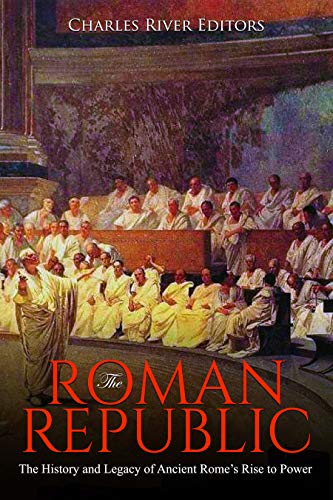The Roman Republic: The History and Legacy of Ancient Rome’s Rise to Power
*Includes pictures*Includes ancient accounts*Includes online resources and a bibliography for further reading*Includes a table of contents “Rome was a poem pressed into service as a city.” In that short line, Anatole Broyard, a 20th century American writer, compactly captures the timeless and enchanting beauty that resides within the Eternal City of Rome. This tourist destination
*Includes pictures
*Includes ancient accounts
*Includes online resources and a bibliography for further reading
*Includes a table of contents
“Rome was a poem pressed into service as a city.” In that short line, Anatole Broyard, a 20th century American writer, compactly captures the timeless and enchanting beauty that resides within the Eternal City of Rome. This tourist destination is often one of the highest ranked on bucket lists, for how could one not want to experience its marvelous ruins, mirror-like rivers, and spectacular stretches of aqueducts firsthand? As one sips on fine Italian wine on a terrace overlooking the grand remnants of the Colosseum, one can practically hear the roars of the battling gladiators and the raucous applause of the spectators. And as one strolls through the coarse, yet quaint cobblestone streets, one can almost hear the galloping horses and screeching wheels of chariots in the distance, and even feel the brush of the breeze as they charge past. It is difficult not to fall in love with a city so effortlessly nostalgic it verges on utopian.
The ambitious and fearless emperors that built the legendary Roman Empire from scratch, the broad-shouldered and bronzed gladiators with their iconic plume helmets and glinting swords, and elaborate parties attended by toga-wearing Romans fueled by alcohol, violence, orgies, and other godless acts all paint a picture of Roman life. Indeed, many people are well-versed with these unique scenes of Roman history, but few are familiar with the equally riveting years preceding the dawn of the Roman Republic, and even less people are acquainted with the fabled Seven Hills sitting east of the Tiber River – the core geographical components of Rome, and the very foundations that the Eternal City was built on.
The study of Roman history is usually divided into three distinct phases: the time of the Kings, the Roman Republic, and the Roman Empire. Roman tradition dated the foundation of Rome to 753 BCE, and this first period of its history ended with the overthrow of King Tarquinius Superbus in 510 BCE. There is very little remaining historical evidence pertaining to this period, so much of what is known is at best legend, possibly based on varying degrees of historical fact. Archaeology has uncovered some details that do tie in with the myths and stories from the era, but by and large it is a period about which little is definitively known.
The period of the Roman Republic, generally dated from 509-27 BCE, is an entirely different matter. There is significant documentation that enables historians to analyze how Rome cemented its position within the Italian peninsula before pushing ever outward to create the new provinces that formed the core of the vast Roman Empire in the third phase that came to dominate all of Europe for so long. The period of the Republic saw those with the emerging powers having to grapple with new political situations, the administration of a diverse domain while contending with political disorder at home, commercial and financial expansion, and complex issues of land distribution, the role of the military, new ideas in religion, and the emergence of new class systems. These years were certainly vibrant and laid the foundations of such characteristics as Roman discipline and the ability to adapt, as well as witnessing the formation of its political structure. The unique farmer-soldier society evolved to the extent that a few Roman citizens were able to dominate their world and time. It was not a tranquil era, but it was one in which those interested in new ideas and philosophies could thrive, and in which the conflicts between the aspirations of the great Roman philosophers and the pragmatically minded senior political and military figures drove the formation of the Roman state and provided the bedrock for its success.
Bestsellers 2021
Auto Amazon Links: No products found.







Comments
Comments are disabled for this post.